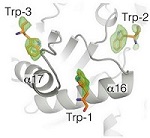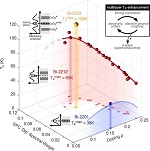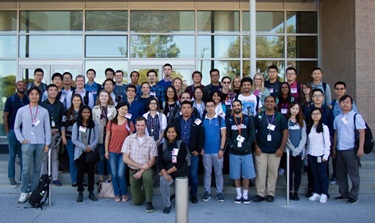Vol. 19, No. 4 - October/November 2018
View the Archives

|
Science Highlights ________________________________________
Revealing the Functional Principles of a Multi-protein Assembly that Uses MicroRNAs – Contact: Ian J. MacRae, The Scripps Research Institute The central dogma of molecular biology posits that the genes in our DNA are transcribed (or “copied”) into messenger RNAs (mRNA), which are then translated (or “read-out”) into the proteins that make up our cells and tissues. Control of gene expression is critical to human health and development. One major mechanism of regulation involves very small RNAs called microRNAs (miRNAs). miRNAs regulate genetic information post-transcription by binding to mRNAs and preventing translation into proteins. It is estimated that about half the protein-coding genes in the human genome are regulated by a miRNA, and breakdown of miRNA systems is increasingly associated with human disease, including many forms of cancer. A central question in miRNA biology is: how do these tiny RNAs effectively regulate mRNAs, which are hundreds or even thousands of times their size? Read more…
Lattice Coupling Conspires in the Correlated Cuprate High-Tc Superconductivity – Contacts: Yu He and Z.-X. Shen, Stanford University / SIMES Materials that act as superconductors at higher temperatures are a subject of intense research, due to their use in magnets and quantum devices, including advanced medical and scientific instruments. Interactions of many quantum-level variables in superconducting materials make these systems difficult to model. The Hubbard Model, proposed in 1963 to explain the behavior of correlated electrons in solid materials and 20 years later applied to high-temperature superconducting materials, has been favored due to its relative simplicity along with limited experimental verification. This model focuses on the exclusively electronic variables for superconductivity, completely neglecting atomic-scale vibrations of the lattice of the material. A team of scientists has challenged the assumption that phonons do not impact high temperature superconductivity through studying a cuprate material. Read more… SSRL-Related News _______________________________________X-rays Show how Periods of Stress Changed an Ice Age Hyena to the Bone Excerpt from November 13, 2018 SLAC News Feature by Ali Sundermier A few hundred thousand years ago during Earth’s most recent ice age, a beefy subspecies of spotted hyena that was more than double the weight of its modern relative roamed Eurasia’s snow-glazed terrain. Until their extinction about 11,000 years ago, these animals, now known as cave hyenas, would drag their prey into dens and devour them with bone-crushing jaws. An international team of researchers has now unearthed what life might have been like for these hulking creatures. They found that despite their massive size, some cave hyenas experienced times of hardship that affected them to the bone, causing areas of arrested growth that appear as dark lines, like rings on a tree trunk. The research, led by Children’s Museum of Indianapolis paleontologist Jennifer Anné and published in the Journal of Analytical Atomic Spectrometry, is part of a larger effort using x-ray fluorescence on BL6-2 at SSRL to map low-concentration, or trace, elements within bone, teasing out biological information about long-extinct animals. Read more… Researchers Create Most Complete High-res Atomic Movie of Photosynthesis to Date November 7, 2018 SLAC Press Release In a major step forward, SLAC’s LCLS x-ray laser captures all four stable states of the process that produces the oxygen we breathe, as well as fleeting steps in between. The work opens doors to understanding the past and creating a greener future. Key components of the work were carried out at SSRL, ALS and the APS. Read more… SSRL Director Kelly Gaffney Interviewed by Live Science X-rays are types of electromagnetic radiation probably most well-known for their ability to see through a person's skin and reveal images of the bones beneath it. Advances in technology have led to more powerful and focused x-ray beams as well as ever greater applications of these light waves. X-rays can be produced on Earth by sending a high-energy beam of electrons smashing into an atom like copper or gallium, according to Kelly Gaffney, Director of SSRL. Enter a synchrotron, a type of particle accelerator that accelerates charged particles like electrons inside a closed, circular path. Since the synchrotron electrons are pushed to near the speed of light, they give off enormous amounts of energy, particularly x-ray energy and a very powerful beam of focused x-ray light. Read more… Meeting Summary _______________________________________EXAFS 2018 Summer Schools on Synchrotron X-ray Absorption Spectroscopy
The hard x-ray spectroscopy group at SSRL organized two summer schools on synchrotron x-ray absorption spectroscopy and EXAFS in 2018. The school held August 13-16 was geared towards international and non-local US participants, while that held between September 10-14 was targeted towards California based participants. The two schools had identical curricula. The first day of the four-day school was devoted to a series of lectures on the theoretical, experimental and practical concepts of x-ray spectroscopy and EXAFS. Leading experts in the field discussed applications to various areas of scientific research. Beam line tour and familiarization sessions were held in the afternoon of the first day, which included training in sample preparation. The second day was devoted to practical experimental design lectures and hands-on training on data visualization, reduction, normalization and analysis using the Athena platform. The next day was devoted to a full day of FEFF based EXAFS analysis using Artemis. The final day of the school was dedicated to in-depth XANES analysis tutorials, which included an introduction to advanced spectroscopy techniques, such as RIXS and HERFD. The school received overwhelming national and international interest for a total of 140 attendees from 13 countries across four continents and 5 industrial partners. The school was supported by DOE-BES, DOE-BER and NIH-NIGMS. News from Light Sources Around the World _________________Lightsources.org is an international collaboration of 27 facilities (21 synchrotrons and 6 XFELs) using a single platform to share communications. Explore the recent science highlights, event calendars and career opportunities for scientists, engineers and technicians! To hear the very latest news every Friday, subscribe to the weekly update. Upcoming Events and Courses _______________________________U.S. Particle Accelerator School (USPAS) – Winter 2019 Session: January 21 – February 1, 2019 Course description websiteUser Research Administration _______________________________System Outage December 26-30 System upgrades are planned during the upcoming holiday break - all SSRL computer infrastructure and networks will be shut down in the evening of Monday 12/26/2018 and will start to come back in the evening Thursday 12/29/2018 or early morning Friday 12/30/2018. All SSRL web services, including the user portal, will be unavailable during this outage. Thank you in advance for your patience! Beam Time Request Deadlines
SSRL Proposal Deadlines
See SSRL Proposal & Scheduling Guidelines and submit proposals and beam time requests through the User Portal. _____________________________________________________________________ The Stanford Synchrotron Radiation Lightsource (SSRL) is a third-generation light source producing extremely bright x-rays for basic and applied research. SSRL attracts and supports scientists from around the world who use its state-of-the-art capabilities to make discoveries that benefit society. SSRL, a U.S. DOE Office of Science national user facility, is a Directorate of SLAC National Accelerator Laboratory, operated by Stanford University for the U.S. Department of Energy Office of Science. The SSRL Structural Molecular Biology Program is supported by the DOE Office of Biological and Environmental Research, and by the National Institutes of Health, National Institute of General Medical Sciences. For more information about SSRL science, operations and schedules, visit http://www-ssrl.slac.stanford.edu. To unsubscribe from SSRL Headlines, just send an e-mail to listserv@slac.stanford.edu with "signoff ssrl-headlines" in the body. To subscribe, send an e-mail to listserv@slac.stanford.edu with "subscribe ssrl-headlines" in the body. Questions? Comments? Contact Tomoko Nakai or Lisa Dunn
|




